Hibiscus
| Hibiscus | |
|---|---|
 | |
| Hibiscus rosa-sinensis | |
| Scientific classification | |
| Kingdom: | Plantae |
| (unranked): | Angiosperms |
| (unranked): | Eudicots |
| (unranked): | Rosids |
| Order: | Malvales |
| Family: | Malvaceae |
| Subfamily: | Malvoideae |
| Tribe: | Hibisceae |
| Genus: | Hibiscus L. |
| Species | |
| Synonyms | |
|
Bombycidendron Zoll. & Moritzi | |
Hibiscus (/hᵻˈbɪskəs/[2] or /haɪˈbɪskəs/[3]) is a genus of flowering plants in the mallow family, Malvaceae. The genus is quite large, comprising several hundred species that are native to warm-temperate, subtropical and tropical regions throughout the world. Member species are renowned for their large, showy flowers and are commonly known simply as hibiscus, or less widely known as rose mallow. The genus includes both annual and perennial herbaceous plants, as well as woody shrubs and small trees. The generic name is derived from the Greek word ἱβίσκος (hibískos), which was the name Pedanius Dioscorides (ca. 40–90) gave to Althaea officinalis.[4]
Description
The leaves are alternate, ovate to lanceolate, often with a toothed or lobed margin. The flowers are large, conspicuous, trumpet-shaped, with five or more petals, color from white to pink, red, orange, peach,[5] yellow or purple,[6] and from 4–18 cm broad. Flower color in certain species, such as H. mutabilis and H. tiliaceus, changes with age.[7] The fruit is a dry five-lobed capsule, containing several seeds in each lobe, which are released when the capsule dehisces (splits open) at maturity. It is of red and white colours. It is an example of complete flowers.
Uses


_in_Hyderabad%2C_AP_W_IMG_9075.jpg)

Symbolism and culture
The hibiscus is the national flower of Haiti and is used in their national tourism slogan of Haïti: Experience It![8][9] The Hibiscus species also represents several other nations. The Hibiscus syriacus is the national flower of South Korea, and Hibiscus rosa-sinensis is the national flower of Malaysia. The red hibiscus is the flower of the Hindu goddess Kali, and appears frequently in depictions of her in the art of Bengal, India, often with the goddess and the flower merging in form. The hibiscus is used as an offering to goddess Kali and Lord Ganesha in Hindu worship. [10]
In the Philippines, the gumamela (local name for hibiscus) is used by children as part of a bubble-making pastime. The flowers and leaves are crushed until the sticky juices come out. Hollow papaya stalks are then dipped into this and used as straws for blowing bubbles. Together with soap, hibiscus juices produce more bubbles.
The hibiscus flower is traditionally worn by Tahitian and Hawaiian girls. If the flower is worn behind the left ear, the woman is married or in a relationship. If the flower is worn on the right, she is single or openly available for a relationship. The hibiscus is Hawaii's state flower.
Nigerian author Chimamanda Ngozi Adichie named her first novel Purple Hibiscus after the delicate flower.
The bark of the hibiscus contains strong bast fibres that can be obtained by letting the stripped bark set in the sea to let the organic material rot away.
Landscaping
Many species are grown for their showy flowers or used as landscape shrubs, and are used to attract butterflies, bees, and hummingbirds.[11]
Hibiscus is a very hardy, versatile plant and in tropical conditions it can enhance the beauty of any garden. Being versatile it adapts itself easily to balcony gardens in crammed urban spaces and can be easily grown in pots as a creeper or even in hanging pots. It is a perennial and flowers through the year. As it comes in a variety of colors, its a plant which can add vibrancy to any garden.
The only infestation that gardeners need to be vigilant about is mealybug. Mealybug infestations are easy to spot as its clearly visible as a distinct white cottony infestation on buds, leaves or even stems. To protect the plant you need to trim away the infected part, spray with water and then spray with a good insecticide recommended by a plant nursery.
Paper
One species of Hibiscus, known as kenaf (Hibiscus cannabinus), is extensively used in paper-making.
Beverage
The tea made of hibiscus flowers is known by many names in many countries around the world and is served both hot and cold. The beverage is well known for its color, tanginess and flavor.
It is known as bissap in West Africa, "Gul e Khatmi" in Urdu & Persian, agua de jamaica in Mexico and Honduras (the flower being flor de jamaica) and Orhul in India. Some refer to it as roselle, a common name for the hibiscus flower. In Jamaica, Trinidad and many other islands in the Caribbean, the drink is known as sorrel (Hibiscus sabdariffa; not to be confused with Rumex acetosa, a species sharing the common name sorrel). In Ghana, the drink is known as soobolo in one of the local languages.
In Cambodia, a cold beverage can be prepared by first steeping the petals in hot water until the colors are leached from the petals, then adding lime juice (which turns the beverage from dark brown/red to a bright red), sweeteners (sugar/honey) and finally cold water/ice cubes.
In Egypt, Sudan and the Arab world, hibiscus tea is known as karkadé (كركديه), and is served as both a hot and a cold drink.
Food
Dried hibiscus is edible, and it is often a delicacy in Mexico. It can also be candied and used as a garnish, usually for desserts.[12]
The roselle (Hibiscus sabdariffa) is used as a vegetable. The species Hibiscus suratensis Linn synonymous to Hibiscus aculeatus G. Don is noted in Visayas Philippines being a souring ingredient for almost all local vegetables and menus. Known as Labog in the Visayan area, (or Labuag/Sapinit in Tagalog), the species is a very good ingredient in cooking native chicken soup.
Hibiscus species are used as food plants by the larvae of some Lepidopteran species, including Chionodes hibiscella, Hypercompe hambletoni, the nutmeg moth, and the turnip moth.
Folk medicine



Hibiscus rosa-sinensis is described as having has a number of medical uses in Chinese herbology.[13]
Precautions and contraindications
Pregnancy and lactation
While the mechanism is not well understood, previous animal studies have demonstrated both an inhibitory effect of H. sabdariffa on muscle tone and the anti-fertility effects of Hibiscus rosa-sinensis, respectively.[6][14] The extract of H. sabdariffa has been shown to stimulate contraction of the rat bladder and uterus;[6] the H.rosa-sinensis extract has exhibited contraceptive effects in the form of estrogen activity in rats.[14] These findings have not been observed in humans. The Hibiscus rosa-sinensis is also thought to have emmenagogue effects which can stimulate menstruation and, in some women, cause an abortion.[15][16][17] Due to the documented adverse effects in animal studies and the reported pharmacological properties, the H. sabdariffa and H.rosa-sinensis are not recommended for use during pregnancy.[17] Additionally, they are not recommended while breastfeeding due to the lack of reliable information on its safety and use.
Adverse effects
Drug interactions
It is postulated that H. sabdariffa interacts with diclofenac, chloroquine and acetaminophen by altering the pharmacokinetics. In healthy human volunteers, the H. sabdariffa extract was found to reduce the excretion of diclofenac upon co-administration.[18] Additionally, co-administration of Karkade (H. sabdariffa), a common Sudanese beverage, was found to reduce chloroquine bioavailability.[19] However, no statistically significant changes were observed in the pharmacokinetics of acetaminophen when administered with the Zobo (H.sabdariffa) drink.[20] Further studies are needed to demonstrate clinical significance.
Species
In temperate zones, probably the most commonly grown ornamental species is Hibiscus syriacus, the common garden hibiscus, also known in some areas as the "Rose of Althea" or "Rose of Sharon" (but not to be confused with the unrelated Hypericum calycinum, also called "Rose of Sharon"). In tropical and subtropical areas, the Chinese hibiscus (H. rosa-sinensis), with its many showy hybrids, is the most popular hibiscus.
Several hundred species are known, including:
|
|
Formerly placed here
|
|
Photos
 A yellow hibiscus in Houston.
A yellow hibiscus in Houston.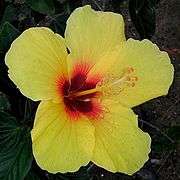

- Hibiscus Flower
- Hibiscus Flower
- Hibiscus Flower
 Hibiscus rosa-sinensis, Mallorca.
Hibiscus rosa-sinensis, Mallorca..jpg) Hibiscus
Hibiscus MultiLayer Yellow hibiscus Velachery
MultiLayer Yellow hibiscus Velachery- Yellow hibiscus
 Yellow hibiscus with red
Yellow hibiscus with red Orange coloured hibiscus
Orange coloured hibiscus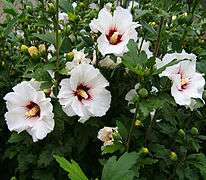 Hibiscus syriacus
Hibiscus syriacus.jpg) White hibiscus with pink touch
White hibiscus with pink touch All white hibiscus in Karnal
All white hibiscus in Karnal Hibiscus moscheutos
Hibiscus moscheutos.jpg) Pink and white hibiscus
Pink and white hibiscus
 Hibiscus Brilliant
Hibiscus Brilliant
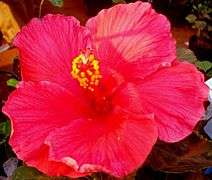

.jpg) Hibiscus furcellatus
Hibiscus furcellatus
_(8058834522).jpg)
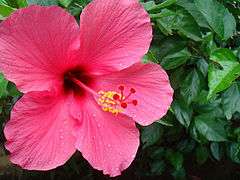 Hibiscus in Bhopal, India
Hibiscus in Bhopal, India
At left, a flower emerges from a bud. At right, the same flower less than 18 hours later. Hibiscus splendens, a rainforest plant from eastern Australia. - Hardy Giant Hibiscus
 Hibiscus syriacus in Bensheim.
Hibiscus syriacus in Bensheim.- Red-layered hibiscus in Trivandrum
.jpg) Hibiscus schizopetalus flower in Trivandrum, Kerala, India.
Hibiscus schizopetalus flower in Trivandrum, Kerala, India. Tricolor hibiscus in Malaysia
Tricolor hibiscus in Malaysia Red hibiscus in Alicante.
Red hibiscus in Alicante. Red hibiscus : The National Flower of Malaysia
Red hibiscus : The National Flower of Malaysia Pink hibiscus in Malaysia
Pink hibiscus in Malaysia- Hibiscus from La Fortuna, Costa Rica

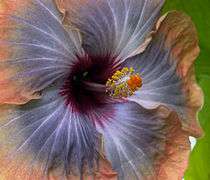 A hibiscus at the United States Botanic Garden located in Washington, D.C
A hibiscus at the United States Botanic Garden located in Washington, D.C

References
- ↑ "Genus: Hibiscus L". Germplasm Resources Information Network. United States Department of Agriculture. 2007-10-05. Retrieved 2010-02-16.
- ↑ Oxford English Dictionary
- ↑ Sunset Western Garden Book, 1995:606–607
- ↑ Lawton, Barbara Perry (2004). Hibiscus: Hardy and Tropical Plants for the Garden. Timber Press. p. 36. ISBN 978-0-88192-654-5.
- ↑ "Hibiscus (National Gardening Association)". Retrieved 26 October 2016.
- 1 2 3 A.M.Fouda, M.Y.Daba & G.M. Dahab. Inhibitory effects of aqueous extracts of Hibiscus sabdariffa on contractility of the rat bladder and uterus. Can.J.Physiol.Pharmacol. 85:1020-1031. (2007)
- ↑ Lee, David Webster (2007). Nature's Palette: the Science of Plant Color. University of Chicago Press. p. 183. ISBN 978-0-226-47052-8.
- ↑ "The World Factbook — Central Intelligence Agency". Retrieved 26 October 2016.
- ↑ Embassy of the Republic of Haiti: The National Flower of Haiti
- ↑ CIA World Factbook: National Symbols
- ↑ "Floridata Master Plant List". Retrieved 26 October 2016.
- ↑ "Page not found". Retrieved 26 October 2016.
- ↑ Plants for a Future: Hibiscus rosa-sinensis. (accessed 07/05/2009)
- 1 2 N.Vasudeva & S.K.Sharma. Post-Coital Antifertility Activity of Hibiscus rosa-sinensis Linn.roots. Evid Based Complement Alternat Med. 5(1): 91-94. (2008)
- ↑ H.J.de Boer & C.Cotingting. Medicinal plants for women’s healthcare in Southeast Asia: a meta-analysis of their traditional use, chemical constituents, and pharmacology. J Ethnopharmacol. 151(2): 747-767. (2014)
- ↑ Ali BH, Al Wabel N & Blunden G. Phytochemical, pharmacological and toxicological aspects of Hibiscus sabdariffa L.: a review. Phytother Res.19(5): 369-375.(2005)
- 1 2 E.Ernst. Herbal medicinal products during pregnancy: are they safe? Br J Obstet Gynaecol. 109: 227-235. (2002)
- ↑ T.O. Fakeye et al. Effects of Water Extract of Hibiscus sabdariffa, Linn (Malvaceae) ‘Roselle’ on Excretion of a Diclofenac Formulation. Phytotherapy Research. 21: 96-98 (2007)
- ↑ B.M. Mahmoud et al. Significant reduction in chloroquine bioavailability following coadministration with the Sudanese beverages Aradaib, Karkadi and Lemon. Journal of Antimicrobial Chemotherapy. 33: 1005–1009 (1994)
- ↑ J.A.Kolawole & A.Maduenyi. Effect of Zobo drink (Hibiscus sabdariffa water extract) on the pharmacokinetics of acetaminophen in human volunteers. Eur J Drug Metab Pharmacokinet. 29(1): 25-29. (2004)
- ↑ "Hibiscus abelmoschus L. — The Plant List". Retrieved 26 October 2016.
- ↑ "Hibiscus abelmoschus var. betulifolius Mast. — The Plant List". Retrieved 26 October 2016.
- ↑ "Hibiscus abelmoschus var. genuinus Hochr. — The Plant List". Retrieved 26 October 2016.
- ↑ "Hibiscus abutiloides Willd. — The Plant List". Retrieved 26 October 2016.
- ↑ "Hibiscus abyssinicus Steud. — The Plant List". Retrieved 26 October 2016.
- ↑ "Hibiscus acapulcensis Fryxell — The Plant List". Retrieved 26 October 2016.
- ↑ "Hibiscus acerifolius Salisb. — The Plant List". Retrieved 26 October 2016.
- ↑ "Hibiscus acerifolius DC. — The Plant List". Retrieved 26 October 2016.
- ↑ "Hibiscus acetosaefolius DC. — The Plant List". Retrieved 26 October 2016.
- ↑ "Hibiscus acetosella Welw. ex Hiern — The Plant List". Retrieved 26 October 2016.
- ↑ Bussmann, R. W., et al. (2006). Plant use of the Maasai of Sekenani Valley, Maasai Mara, Kenya. J Ethnobiol Ethnomed 2 22.
- ↑ "GRIN Species Records of Hibiscus". Germplasm Resources Information Network. United States Department of Agriculture. Retrieved 2011-02-10.
External links
| Wikispecies has information related to: Hibiscus |
- American Hibiscus Society (AHS)
- Australian Hibiscus Society
- International Hibiscus Society
- Foundation for Revitalisation of Local Health Traditions
- Dressler, S.; Schmidt, M. & Zizka, G. (2014). [http://www.africanplants.senckenberg.de/root/index.php?submitForm=true&page_id=77&searchTextMenue=Hibiscus&filterRegionIDs[]=6&filterRegionIDs[]=1&filterRegionIDs[]=2&filterRegionIDs[]=3&filterRegionIDs[]=5 "Hibiscus"]. African plants – a Photo Guide. Frankfurt/Main: Forschungsinstitut Senckenberg.
| Wikimedia Commons has media related to Hibiscus. |